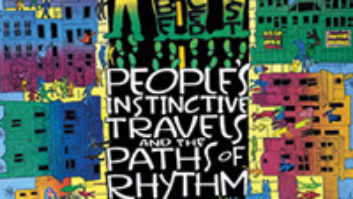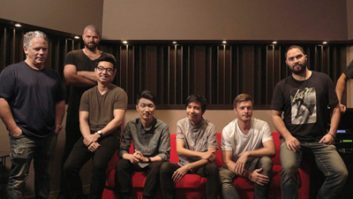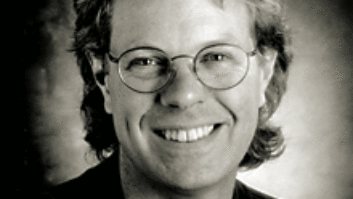Joel Dorn is a lifer, in a musical sense of the word, and his latest venture, Label M, gives him a crack at bringing a lot of important, historic, previously unheard jazz before the public.“This is exciting — there’s a sense of discovery every day,” says the producer. “It’s like going into a mine and saying, ‘That looks like gold,’ and you come out with something. We listen to a lot of tapes — you gotta kiss a lot of frogs before one of them turns into a handsome prince. But we found some great Coleman Hawkins the other day, at the end of his life. That’s a big deal.”
“Technology has allowed us to put this stuff in a form where people can still look and listen. It’s almost a teaching tool to young students,” says Dorn’s engineer of some 30 years, Gene Paul. “You listen and realize that people don’t play that way now. So you are privy to being as close to that club, as close to that performance, as close to that spirit that was happening at the time, and technology is allowing us to snoop back into that zone.”
Dorn’s previous venture, 32 Jazz, was successful in deconstructing and reconstructing the Muse record label and creating “lifestyle records” — compilations of work by jazz artists, such as Ron Carter, Woody Shaw, Houston Person, Hank Jones, David Newman and Sonny Stitt, known as the “Jazz For…” series. “Not bullshit jazz, not cop-out jazz, real jazz,” Dorn says, “but real jazz that was accessible to people who weren’t necessarily jazz fans. We made mood albums, and basically it was an extension of my DJ days, where you put on an hour of good music.
“At Label M, we don’t have an existing label as our wellspring,” he adds. “What we have are collections of live music that I’ve been stashing for the last 15 or 20 years. The hope has been to someday have a label built around live unreleased music in a variety of genres by major artists at the peak of their powers.” Much of the first live product on Label M is from a large collection of reel-to-reel tapes originally recorded by Vernon Welsh at the Famous Ballroom in Baltimore, chronicling Left Bank Jazz Society events in the 1960s and ’70s. First releases included Stan Getz’ My Foolish Heart, Al Cohn and Zoot Sims Live at the Left Bank, Cedar Walton Live at the Left Bank and Sonny Stitt’s Just the Way It Was.
There is also a subterranean world of people outside the music business who have tapes that were recorded on an amateur basis. “Someone else might say ‘illegally,’” Dorn quips. “What we do is get clearances on them, get the rights, pay the artists and make them legal and legitimate and put them out. Once the word gets out that you’re looking, lots of musicians have tapes of their own. A soundman will say, ‘Here — here’s your performance tonight.’ Now we get tapes every day from people.” Dorn’s son, Adam, helps to gather and listen to material, along with others at the label. “The jungle drums are out there on us in the tape collecting world,” Joel says. “Lots of people are contacting us. So you put it on — you either like it or you don’t like it. I don’t want to make this sound like there’s any great mystery to it.”
Most of this stuff is just feathers — the more you touch it and make it right, the wronger it becomes. As stupid as it may sound, it’s what you don’t do to it that makes it great. Leave it as honest as you can.
— Gene Paul
“Most of this old stuff was recorded almost by mistake,” says Gene Paul. “The Left Bank collection was recorded reel-to-reel, 3¾, half-mil, Mylar tape, quarter-track. I don’t think you could do any worse. They put the piano in mono on one side, with the drums and the bass. The other side would be two horns or a horn and a vibe or something. And we would make a DAT of these tapes right away, because with the mylar tape, being half-mil, you run into certain problems. When it stops quickly, it stretches the tape, and the tape literally turns into a thread, so that portion of tape you cut off and throw away. Once the mylar stretches, it’s over. Once you put it on and start playing it, you must continue through the whole side. It’s so thin that you can barely thread it without it bending and fraying and falling apart. And it’s quarter-track, which means you have two channels going one way, and then you turn the tape over and there’s two more. But when all is said and done, the music really lifts it to a point where you say, ‘Listen to what he’s playing.’
“It’s brilliant Stan [Getz],” Paul continues. “Sonny Stitt’s the same. We had to have gone through eight or 10 hours of music. Joel and I just sit there, and when it hits, it hits. Joel says, ‘Do you think you can dig the sound out?’ If it survives getting through it and everybody says, ‘Did you hear Getz?,’ that’s the key. Getz was on a good night. There are moments that you hear the honesty. You hear something go down that had nothing to do with the red light. That privilege of searching in the treasure chest is just overwhelming, because many times you see a side that never existed on record. When this one came by, everybody in the room sat up. And if you can polish it a little bit and not lose that…
“We do a little No Noise, we do a few things of the technical world; we’re not the Flintstones,” the engineer continues. “But when No Noise starts to become music, I stop. I’d rather hear noise than hear the band scalped. So I’ll stop there, and noise is my friend. The music has to be so focused and so spectacular that it truly extends all of the flaws. You just don’t see them anymore. If you’re into Getz, there’s no way you’re going to stop listening to Getz to listen to some flaw.
“We’re using Sonic Solutions,” Paul says. “In this case, we’re coming off an Otari 50/50 quarter-track reel-to-reel. We’re going through some real fine Apogees, and we’re going into a Yamaha digital mixer in order to try and spread this a little bit. And then the mix is mostly passive. It’s just a tool to add maybe a little room sound, a little echo and spread it out very gently. Most of this stuff is just feathers — the more you touch it and make it right, the wronger it becomes. As stupid as it may sound, it’s what you don’t do to it that makes it great. Leave it as honest as you can, and then through that process we go into Sonics, and if we have to brush it, we’ll brush it, and if we have to do some little level increments inside, we’ll do that. A little bit of No Noise, something minor that doesn’t take the room out.”
Dorn and Paul were behind the board during pop’s “Golden era,” as staffers for Atlantic Records in the ’60s and ’70s. Dorn won Grammys with Roberta Flack (“First Time Ever I Saw Your Face” and “Killing Me Softly With His Song”) and produced the likes of Charles Mingus, Rahsaan Roland Kirk, Leon Redbone, Bette Midler, the Neville Brothers and Lou Rawls, after an apprenticeship under Neshui Ertegun. They were magic times at Atlantic. “It screwed me up for the rest of my life, because I thought that’s the way it was,” he says. “I figured I’d still be making records at Atlantic with Fathead [Newman]. A little naive on my part.”
One of the hardest parts of Dorn’s current job is hearing a great live performance on tape and realizing there’s no way to make the audio presentable. “There’s a delicate balance there,” Dorn says. “There’s a point at which I don’t care how great the performance is; sonically it has to at least be sound. What we obviously listen for is ‘A’ performance and ‘A’ sound. But if you have ‘A+’ performance and ‘B’ sound, after a moment or so the performance transcends the sound. But we won’t go too far. For an absolutely brilliant performance we’ll bend a little bit for sound, but not much. And, conversely, brilliant sound in and of itself means nothing if the performance is dull. So our batting average is very low. We’ll listen to 100 tapes and we’ll get two-and-a-half or three albums out of it. But those albums meet the requirements.”
Editing is just a part of the process, according to Dorn. “You don’t over-edit, like you don’t over-equalize or over-Sonic Solution. But after you’ve been doing this for a while, you get a sense of how to reduce a performance without changing its basic character. Maybe focus a little better. It still has to be natural, it has to have its feel. If someone says that was a great live performance and doesn’t know we took four minutes out of a 12 minute piece, we did okay.”
“Some of these choruses are way over-extended,” adds Paul, “and everybody but the bartender takes a chorus. The good part is that they play enough that within that passage you’ve got a moment there that’s brilliant. Then you’ve got an option to tighten it up a little bit.”
Label M is also in the business of re-releasing out-of-print records, such as Joe Williams’ classic vocal album A Man Ain’t Supposed To Cry (Roulette), as well as Atlantic classics (produced by Dorn, Arif Mardin and Neshui Ertegun) by David Newman, Les McCann and Eddie Harris, and Rufus Harley. But Dorn and Paul are focusing the label more toward live performances. They received a four-star review in the February 2001 Downbeat for Ray Bryant’s Somewhere in France. Gene Paul recalls the discovery of that concert tape: “Joel kept prodding Ray to see if he had any tapes, and Ray finally called Joel up and said, ‘You have no idea what I’ve found. I’ve got a performance from Europe — I don’t know where it was.’ The quality of the performance and the sound is so good you’d swear it was done with a truck. The crowd sounds like Avery Fisher Hall, the talking is just marvelous and it was all done on an audio cassette.”
“The beauty of what we have with these tapes is that the musicians never knew they were being recorded, so they were just doing their gig,” says Dorn. “The pressure of recording live wasn’t there. In the ’60s and ’70s, I saw Cannonball Adderley and Horace Silver a hundred times. I know what it was like back then, and I’m trying to document that period. With the live records, some of them are stunning, some of them have incredible sound, but all of them have something that’s evocative of that era.”
“We can go in there and divide people, and make it so quiet that you’d swear it was done six years ago,” says Paul. “But when you finish with it, it doesn’t have the magic like when you went to a club and saw a performance that was just incredible, even if the sound was mediocre. It all had to do with the atmosphere, with the air conditioning and the smoke…and they performed to whatever the bad parts of the room were. And when you try to correct that, it alters what they’re doing. It really boils down to, do you have goose bumps going up your arm and how does it feel? We like to get as good a top end and as good a bottom and clarity as we can get, but never giving up that feeling.”





